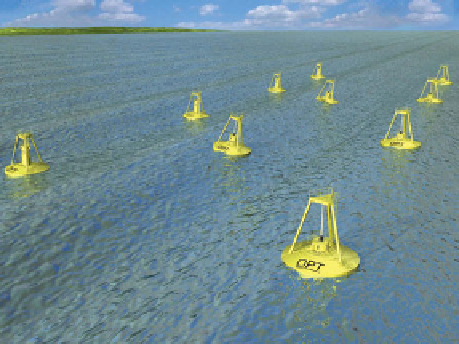Geoscience Reference
In-Depth Information
per minute) needed to convert mechanical energy to
electrical energy in a
generator
. Some modern wind
turbines are gearless, with the shaft connected directly
to the generator. To compensate for the slow spin rate in
the generator in gearless turbines, the radius of rotation
is expanded, increasing the speed at which magnets
move around a coil in the generator to produce elec-
tricity. The efficiency of wind power increases with
increasing turbine hub height because wind speeds
generally increase with increasing height in the lower
atmosphere. As such, larger turbines capture faster
winds. Wind farms are often located on flat open land
(Figure 13.3a), within mountain passes, on ridges, and
offshore (Figure 13.3b). Individual turbines range in
size up to 10 MW. High-altitude wind energy capture is
also being pursued. Small turbines (e.g., 1-10 kW) are
convenient for producing local electricity in the back-
yards of homes or city street canyons if winds are fast.
produced by Pelamis Wave Power Ltd., is a floating
snakelike device 180 m long by 4 m wide, with cylin-
drical sections connected by moveable joints. Up-and-
down motion along the device increases the pressure on
oil within it to drive a hydraulic ram to run a hydraulic
motor, whose rotating motion is converted to electricity
in a generator.
13.2.3. Geothermal
Geothermal energy
is energy extracted from hot water
and steam below the Earth's surface. Steam or hot water
from the Earth has historically been used to provide
heat for buildings, industrial processes, and domestic
water. The first use of geothermal energy to generate
electricity was by
Prince Piero Conti
of
Larderello
,
Tuscany, Italy, in 1904. He lit four light bulbs by using
steam from geothermal fields near his palace to drive a
steam-driven engine attached to a generator. In 1911,
he installed the first geothermal power plant, which had
a capacity of 250 kW. This plant grew to 405 MW by
1975. The second electricity-producing plant was built
at the Geysers Resort Hotel, California, in 1922. This
plant was originally used only to generate electricity for
the resort, but it has since been developed to produce
electricity for the state.
Today, three major types of geothermal plants are dry
steam, flash steam, and binary.
Dry and flash steam
geothermal plants
operate where geothermal reservoir
temperatures are 180
◦
Cto370
◦
Corhigher. In both
cases, two boreholes are drilled - one for steam alone
(in the case of dry steam) or liquid water plus steam
(in the case of flash steam) to flow up, and the second
for condensed water to return after it passes through the
plant. In the dry steam plant, the pressure of the steam
rising up the first borehole powers a turbine, which
drives a generator to produce electricity. About 70 per-
cent of the steam recondenses after it passes through a
condenser, and the rest is released to the air. Because
CO
2
(g), NO(g), SO
2
(g), and H
2
S(g) in the reservoir
steam do not recondense along with water vapor, these
gases are emitted to the air. Theoretically, they could be
captured, but this has not been done to date. In a flash
steam plant, the liquid water plus steam from the reser-
voir enters a flash tank held at low pressure, causing
some of the water to vaporize (“flash”). The vapor then
drives a turbine. About 70 percent of this vapor is recon-
densed. The remainder escapes with CO
2
(g) and other
gases. The liquid water is injected back to the ground.
Binary geothermal plants
are developed when the
reservoir temperature is 120
◦
Cto180
◦
C. Water rising
13.2.2. Wave
Winds passing over water create surface waves. The
faster the wind speed, the longer a wave is sustained, the
greater the distance it travels, and the greater its height.
Wave powerdevices
capture energy from ocean sur-
face waves to produce electricity. One type of device
(Figure 13.4), produced by Ocean Power Technologies,
Inc., bobs up and down with a wave, creating mechani-
cal energy that is converted to electricity in a generator.
The electricity is sent through an underwater transmis-
sion cable to shore. Most of the body of this device
is submerged under water. Another type of device,
Figure 13.4.
Artist rendering of a field of wave
converters used to generate electricity, as described
in the text. Photo courtesy of Ocean Power
Technologies, Inc.


Search WWH ::

Custom Search